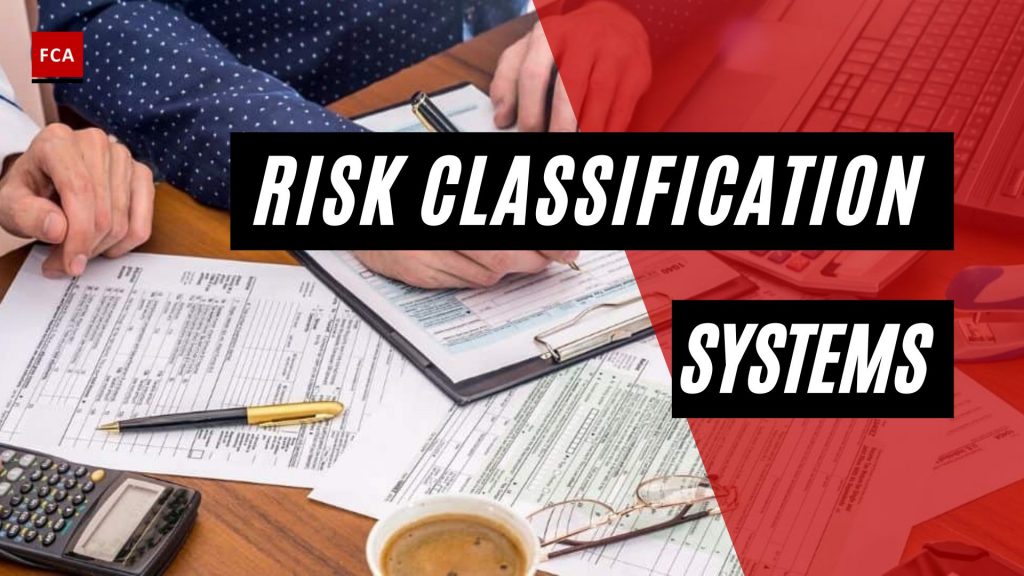Los sistemas de clasificación de riesgos. La identificación de los riesgos y su categorización en categorías de riesgo adecuadas son fundamentales para los procedimientos de gestión del riesgo empresarial. La categorización de los riesgos hace posible la evaluación de los riesgos inherentes y residuales de los distintos procesos y actividades. Sin categorizar los riesgos en tipos o clases adecuadas, la dirección puede ser incapaz de examinar adecuadamente los riesgos asociados a los distintos procesos y departamentos. El riesgo debe clasificarse en función de su tipo, naturaleza y complejidad.

Sistemas de clasificación de riesgos
Para categorizar los riesgos, las organizaciones deben identificar primero las fuentes de los riesgos, incluyendo la identificación de posibles fuentes de información, datos, investigación e informes que puedan ayudar a los propietarios de los riesgos a identificar sus fuentes de riesgo relevantes y aplicables. Esto permite a las organizaciones clasificar sus riesgos y analizar el efecto y la probabilidad de cada uno. Los informes de auditoría interna, los informes de inspección del regulador, los datos históricos de pérdidas, la información financiera, los datos de quejas de los clientes, la base de datos de noticias, los eventos de peligro registrados, los datos de sanciones, etc. son ejemplos de fuentes de riesgo.
El proceso de identificación de riesgos de la organización y todos los departamentos y propietarios de procesos entienden estas fuentes para identificar sus riesgos relevantes de estas fuentes. Sin la identificación de las fuentes de riesgo y el paisaje, los riesgos pueden no identificarse de manera completa o precisa, lo que resulta en una evaluación y gestión de riesgos incompleta.
Consejo de Administración
El Consejo de Administración, a través de la alta dirección, se asegura de que se establezcan todas las fuentes de riesgo y de que cada jefe de departamento con los empleados lea y comprenda los requisitos y propósitos del universo o fuentes de riesgo. Después de una comprensión adecuada de las fuentes de riesgo, se identifican los riesgos clave y significativos.
El objetivo es garantizar que se identifiquen y clasifiquen los riesgos relevantes y significativos en función de su naturaleza y tipo. La clasificación de riesgos permite a los propietarios de la gestión y del proceso comprender la importancia y la categoría de los riesgos detectados, que pueden clasificarse como altos, medios o bajos en función de los criterios de evaluación de riesgos que se han establecido.
Clasificación del riesgo
La clasificación de los riesgos se consigue mediante la definición de los criterios de evaluación de riesgos cuantitativos y cualitativos. Una vez identificados los riesgos y etiquetados con los tipos de riesgo, se realiza la evaluación de los riesgos inherentes y residuales teniendo en cuenta el nivel de controles existentes para mitigarlos. Después de realizar la evaluación del riesgo residual, los riesgos se clasifican en tres grandes niveles, que son riesgos altos, riesgos medios y riesgos bajos.
La organización considera la criticidad de la función y el proceso al que pertenece el riesgo durante la categorización del mismo. Los departamentos y procesos clave se priorizan constantemente, y los riesgos asociados suelen etiquetarse como altos para garantizar que todos los procedimientos críticos se evalúan con frecuencia desde el punto de vista de la gestión de riesgos. Esto es necesario porque el riesgo en procesos esenciales puede resultar en grandes pérdidas financieras, operativas, de reputación y estratégicas.
Esta categorización permite a la dirección clasificar los peligros de alto nivel como riesgos prioritarios para su seguimiento y gestión. Todos los peligros de alto nivel de las distintas funciones se agregan para ofrecer una imagen más completa de los principales peligros a los que es vulnerable una organización. Una vez que se han agregado todos los riesgos clasificados de alto nivel, cada propietario de proceso comienza a implementar los procedimientos y controles necesarios que deben existir para mitigar dichos riesgos de alto nivel.
Riesgos emergentes
También se examinan y clasifican los riesgos emergentes a medida que surgen cuando el contexto empresarial evoluciona y tienen el potencial de afectar al perfil de riesgo de la entidad en el futuro. Cabe señalar que es posible que los riesgos emergentes no se conozcan lo suficiente como para identificarlos y evaluarlos de forma eficaz desde el principio, lo que hace necesaria una reidentificación más frecuente.
Las organizaciones también deben comunicar la nueva información sobre los riesgos en desarrollo a medida que esté disponible. Identificar los riesgos nuevos y emergentes y los cambios en los riesgos actuales ayuda a la empresa a mirar hacia delante y planificar el futuro, dándole tiempo para analizar la posible gravedad de los riesgos, así como para capitalizar estos desarrollos. En consecuencia, disponer de tiempo para examinar el riesgo permite a la empresa anticiparse a la respuesta al riesgo o, si es necesario, revisar la estrategia y los objetivos empresariales de la entidad. Algunos riesgos pueden seguir siendo riesgos no descubiertos para los cuales la compañía no tiene una expectativa razonable de considerar durante la identificación de riesgos .
Riesgos de nivel medio y bajo
Los riesgos de nivel medio y bajo no se ignoran, pero se les da una segunda prioridad en términos de supervisión. Siempre es concebible que los riesgos categorizados como de nivel medio se conviertan en riesgos de nivel alto como resultado de cambios en las prácticas empresariales, cambios legislativos, etc. Como resultado, se recomienda igualmente el monitoreo constante de tales amenazas categorizadas de nivel medio por parte de la gerencia.
Prácticas actuales
Como resultado de la experiencia, a lo largo de los años se han diseñado, implementado y modificado una gran cantidad de sistemas de clasificación de riesgos. Es probable que la ciencia médica, la economía y otras disciplinas, así como la ciencia actuarial, den lugar a una evolución continua de estos sistemas. Aunque es imposible predecir con certeza la evolución futura, los actuarios en activo pueden tomar medidas razonables para mantenerse al día en las prácticas emergentes y actuales. Estas prácticas pueden diferir significativamente según el ámbito de la práctica. Por ejemplo, las clases de riesgo de los seguros de vida voluntarios pueden subdividirse para reflejar la salud, el hábito de fumar y la ocupación del solicitante, mientras que estos factores suelen ignorarse en los sistemas de pensiones.
Gestión de riesgos
El proceso de identificar, evaluar y controlar las amenazas al capital y los beneficios de una organización se conoce como gestión de riesgos. Estos riesgos surgen de diversas fuentes, como la incertidumbre financiera, las responsabilidades legales, los problemas tecnológicos, los errores de gestión estratégica, los accidentes y las catástrofes naturales.
Un programa exitoso de gestión de riesgos ayuda a una organización a considerar todos los riesgos a los que se enfrenta. La gestión de riesgos también investiga la relación entre los riesgos y la posibilidad de que tengan un impacto en cascada sobre los objetivos estratégicos de una organización.
Importancia de la gestión de riesgos
La gestión de riesgos nunca ha sido tan importante como ahora. Debido al rápido ritmo de la globalización, los riesgos a los que se enfrentan las organizaciones modernas se han vuelto más complejos. Regularmente surgen nuevos riesgos, muchos de los cuales están relacionados con el uso de la tecnología digital o son generados por ella. Los expertos en riesgos han bautizado el cambio climático como un «multiplicador de amenazas».
La pandemia de coronavirus, que recientemente se manifestó como un problema de la cadena de suministro en muchas empresas, evolucionó rápidamente hasta convertirse en una amenaza existencial, que afecta a la salud y la seguridad de sus empleados, a los medios de hacer negocios, a la capacidad de interactuar con los clientes y a la reputación corporativa.
Reflexiones finales
Desde los inicios de la profesión, la clasificación de riesgos ha sido un componente esencial de la práctica actuarial. El fracaso de las sociedades de tasación del siglo XIX, en las que los seguros de vida se ofrecían con tarifas que ignoraban la edad, ejemplificó las dificultades financieras y la falta de equidad que pueden derivarse de ignorar el impacto de las diferencias en las características del riesgo. El incumplimiento de los principios actuariales relativos a la clasificación del riesgo para las coberturas voluntarias puede dar lugar a una infrautilización del sistema de seguridad financiera o personal y, por lo tanto, a la falta de cobertura para los individuos de menor riesgo, así como a una cobertura con tarifas insuficientes para los individuos de mayor riesgo, poniendo en peligro la viabilidad del sistema.








